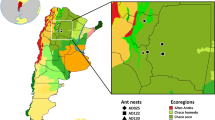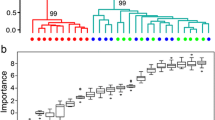Abstract
Although several neurobiological and genetic correlates of aging and behavioral development have been identified in social insect workers, little is known about how other age-related physiological processes, such as muscle maturation, contribute to task performance. We examined post-eclosion growth of three major muscles of the head capsule in major and minor workers of the ant Pheidole dentata using workers of different ages with distinct task repertoires. Mandible closer muscle fibers, which provide bite force and are thus critical for the use of the mandibles for biting and load carrying, fill the posterio-lateral portions of the head capsule in mature, older workers of both subcastes. Mandible closer fibers of newly eclosed workers, in contrast, are significantly thinner in both subcastes and grow during at least the next 6 days in minor workers, suggesting this muscle has reduced functionality for a substantial period of adult life and thus constrains task performance capability. Fibers of the antennal muscles and the pharynx dilator, which control antennal movements and food intake, respectively, also increase significantly in thickness with age. However, these fibers are only slightly thinner in newly eclosed workers and attain their maximum thickness over a shorter time span in minors. The different growth rates of these functionally distinct muscles likely have consequences for how adult P. dentata workers, particularly minors, develop their full and diverse task repertoire as they age. Workers may be capable of feeding and interacting socially soon after eclosion, but require a longer period of development to effectively use their mandibles, which enable the efficient performance of tasks ranging from nursing to foraging and defense.





Similar content being viewed by others
References
Alaux C, Sinha S, Hasadsri L, Hunt GJ, Guzman-Novoa E, DeGrandi-Hoffman G, Uribe-Rubio JL, Southey BR, Rodriguez-Zas S, Robinson GE (2009) Honey bee aggression supports a link between gene regulation and behavioral evolution. Proc Natl Acad Sci USA 106:15400–15405
Arrese EL, Soulages JL (2010) Insect fat body: energy, metabolism, and regulation. Annu Rev Entomol 55:207–225
Barron AB, Robinson GE (2005) Selective modulation of task performance by octopamine in honey bee (Apis mellifera) division of labour. J Comp Physiol A 191:659–668
Barron AB, Maleszka R, Vander Meer RK, Robinson GE (2007) Octopamine modulates honey bee dance behavior. Proc Natl Acad Sci USA 104:1703–1707
Bayline RJ, Duch C, Levine RB (2001) Nerve–muscle interactions regulate motor terminal growth and myoblast distribution during muscle development. Dev Biol 231:348–363
Beshers SN, Fewell JH (2001) Models of division of labor in social insects. Annu Rev Entomol 46:413–440
Brown SM, Napper RM, Mercer AR (2004) Foraging experience, glomerulus volume, and synapse number: a stereological study of the honey bee antennal lobe. J Neurobiol 60:40–50
Calabi P, Traniello JFA (1989a) Behavioral flexibility in age castes of the ant Pheidole dentata. J Insect Behav 2:663–677
Calabi P, Traniello JFA (1989b) Social organization in the ant Pheidole dentata: physical and temporal caste ratios lack ecological correlates. Behav Ecol Sociobiol 24:69–78
Chapman RF (1998) The insects: structure and function, 4th edn. Cambridge University Press, Cambridge
de Kort CAD (1990) Thirty-five years of diapause research with the Colorado potato beetle. Entomol Exp Appl 56:1–13
Ehmer B, Gronenberg W (1997) Antennal muscles and fast antennal movements in ants. J Comp Physiol B 167:287–296
Elder HY (1975) Muscle structure. In: Usherwood PNR (ed) Insect muscle. Academic, London, pp 1–74
Fernandes JJ, Keshishian H (1998) Nerve–muscle interactions during flight muscle development in Drosophila. Development 125:1769–1779
Fernandes JJ, Keshishian H (2005) Motoneurons regulate myoblast proliferation and patterning in Drosophila. Dev Biol 277:493–505
Finlayson LH (1975) Development and degeneration. In: Usherwood PNR (ed) Insect muscle. Academic, London, pp 75–149
Gronenberg W, Ehmer B (1995) Tubular muscle fibers in ants and other insects. Zoology 99:68–80
Gronenberg W, Riveros AJ (2009) Social brains and behavior—past and present. In: Gadau J, Fewell J (eds) Organization of insect societies: from genome to sociocomplexity. Harvard University Press, Cambridge, pp 377–401
Gronenberg W, Paul J, Just S, Holldobler B (1997) Mandible muscle fibers in ants: fast or powerful? Cell Tissue Res 289:347–361
Haunerland NH, Shirk PD (1995) Regional and functional differentiation in the insect fat body. Annu Rev Entomol 40:121–145
Hölldobler B, Wilson EO (1990) The ants. Harvard University Press, Cambridge
Hughes SM, Salinas PC (1999) Control of muscle fibre and motoneuron diversification. Curr Opin Neurobiol 9:54–64
Ishikawa Y, Aonuma H, Miura T (2008) Soldier-specific modification of the mandibular motor neurons in termites. PLoS ONE 3:e2617
Jensen PV, Borgesen LW (2000) Regional and functional differentiation in the fat body of pharaoh’s ant queens, Monomorium pharaonis (L.). Arthropod Struct Dev 29:171–184
Jones TA, Donlan NA, O’Donnell S (2009) Growth and pruning of mushroom body Kenyon cell dendrites during worker behavioral development in the paper wasp, Polybia aequatorialis (Hymenoptera: Vespidae). Neurobiol Learn Mem 92:485–495
Kühn-Bühlmann S, Wehner R (2006) Age-dependent and task-related volume changes in the mushroom bodies of visually guided desert ants, Cataglyphis bicolor. J Neurobiol 66:511–521
Marden JH (2000) Variability in the size, composition, and function of insect flight muscles. Annu Rev Physiol 62:157–178
Muscedere ML, Willey TA, Traniello JFA (2009) Age and task efficiency in the ant Pheidole dentata: young minor workers are not specialist nurses. Anim Behav 77:911–918
O’Donnell S, Jeanne RL (1993) Methoprene accelerates age polyethism in workers of a social wasp (Polybia occidentalis). Physiol Entomol 18:189–194
Patek SN, Baio JE, Fisher BL, Suarez AV (2006) Multifunctionality and mechanical origins: ballistic jaw propulsion in trap-jaw ants. Proc Natl Acad Sci USA 103:12787–12792
Paul J (2001) Mandible movements in ants. Comp Biochem Physiol A 131:7–20
Paul J, Gronenberg W (1999) Optimizing force and velocity: mandible muscle fibre attachments in ants. J Exp Biol 202:797–808
Paul J, Gronenberg W (2002) Motor control of the mandible closer muscle in ants. J Insect Physiol 48:255–267
Paul J, Roces F, Hölldobler B (2002) How do ants stick out their tongues? J Morphol 254:39–52
Riveros AJ, Gronenberg W (2010) Brain allometry and neural plasticity in the bumblebee Bombus occidentalis. Brain Behav Evol 75:138–148
Roberts SP, Elekonich MA (2005) Muscle biochemistry and the ontogeny of flight capacity during behavioral development in the honey bee, Apis mellifera. J Exp Biol 208:4193–4198
Robinson GE (1987) Regulation of honey bee age polyethism by juvenile hormone. Behav Ecol Sociobiol 20:329–338
Robinson EJH (2009) Physiology as a caste-defining feature. Insectes Soc 56:1–6
Robinson GE, Page RE (1989) Genetic basis for division of labor in an insect society. In: Breed MD, Page RE (eds) The genetics of social evolution. Westview, Boulder, pp 61–80
Robinson GE, Page RE, Huang Z-Y (1994) Temporal polyethism in social insects is a developmental process. Anim Behav 48:467–469
Rose U (2004) Morphological and functional maturation of a skeletal muscle regulated by juvenile hormone. J Exp Biol 207:483–495
Schippers MP, Dukas R, McClelland GB (2010) Lifetime- and caste-specific changes in flight metabolic rate and muscle biochemistry of honeybees, Apis mellifera. J Comp Physiol B 180:45–55
Schulz DJ, Robinson GE (2001) Octopamine influences division of labor in honey bee colonies. J Comp Physiol A 187:53–61
Seid MA, Traniello JFA (2005) Age-related changes in biogenic amines in individual brains of the ant Pheidole dentata. Naturwissenschaften 92:198–201
Seid MA, Traniello JFA (2006) Age-related repertoire expansion and division of labor in Pheidole dentata (Hymenoptera: Formicidae): a new perspective on temporal polyethism and behavioral plasticity in ants. Behav Ecol Sociobiol 60:631–644
Seid MA, Harris KM, Traniello JFA (2005) Age-related changes in the number and structure of synapses in the lip region of the mushroom bodies in the ant Pheidole dentata. J Comp Neurol 488:269–277
Seid MA, Goode K, Li C, Traniello JFA (2008) Age- and subcaste-related patterns of serotonergic immunoreactivity in the optic lobes of the ant Pheidole dentata. Dev Neurobiol 68:1325–1333
Smith CR, Toth AL, Suarez AV, Robinson GE (2008) Genetic and genomic analyses of the division of labour in insect societies. Nat Rev Genet 9:735–748
Stieb SM, Muenz TS, Wehner R, Rossler W (2010) Visual experience and age affect synaptic organization in the mushroom bodies of the desert ant Cataglyphis fortis. Dev Neurobiol 70:408–423
Termier M (1970) Anatomie et évolution de la musculature a l’état adulte chez Ips sexdentatus (Col. Scolytidae). Ann Soc Ent Fr 6:721–732
Traniello JFA (2010) Pheidole: sociobiology of a highly diverse genus. In: Breed M, Moore J (eds) Encyclopedia of animal behavior, vol 2. Elsevier, Amsterdam, pp 699–706
Wilson EO (1976a) Behavioral discretization and number of castes in an ant species. Behav Ecol Sociobiol 1:141–154
Wilson EO (1976b) The organization of colony defense in the ant Pheidole dentata Mayr (Hymenoptera: Formicidae). Behav Ecol Sociobiol 1:63–81
Withers GS, Fahrbach SE, Robinson GE (1995) Effects of experience and juvenile hormone on the organization of the mushroom bodies of honey bees. J Neurobiol 26:130–144
Acknowledgments
We thank Lloyd Davis for collecting the ant colonies used in this study. This work was supported by a National Science Foundation (NSF) Graduate Research Fellowship to MLM and NSF Grants IOB 0725013 and 0724591 to JFAT and WG.
Author information
Authors and Affiliations
Corresponding author
Additional information
Communicated by: Sven Thatje
Rights and permissions
About this article
Cite this article
Muscedere, M.L., Traniello, J.F.A. & Gronenberg, W. Coming of age in an ant colony: cephalic muscle maturation accompanies behavioral development in Pheidole dentata . Naturwissenschaften 98, 783 (2011). https://doi.org/10.1007/s00114-011-0828-6
Received:
Revised:
Accepted:
Published:
DOI: https://doi.org/10.1007/s00114-011-0828-6




